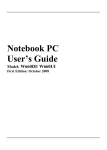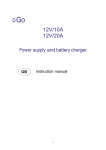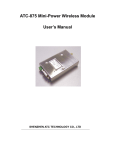Download This guide can help you understand rechargeable
Transcript
BATTERY CARE GUIDE BATTERY CARE GUIDE This guide can help you understand rechargeable batteries and proper handling that will maximize your battery life. New Batteries A new rechargeable battery comes in a discharged condition and must be charged before use (refer to the manual for specific charging instructions). Upon initial use (or after a prolonged storage period) the battery may require three to four charge/discharge cycles before achieving maximum capacity. It is important to condition (fully discharge and then fully charge) the battery every two to three weeks. Failure to do so can significantly shorten the battery's life. To discharge, simply run the flashlight until it completely discharges. Then recharge the battery as instructed in the user's manual. It is normal for a battery to become warm to the touch during charging and discharging. Battery Handling If the battery will not be in use for a month or longer, it is recommended that it be removed from the device and stored in a cool, dry, clean place. A charged battery will eventually lose its charge if unused. It may therefore be necessary to recharge the battery after a storage period. Actual battery run-time depends upon the power demands made by the equipment it powers. The total run-time of the battery is also heavily dependent upon the design of the equipment. Here are some basic tips for battery handling: - Do not short-circuit. As it may cause severe damage to the battery or even explosion. Avoid dropping or impacting batteries. This could result in the exposure of the corrosive cell contents. Avoid exposing the battery to moisture or rain. Always keep batteries away from fire or other sources of extreme heat. Never incinerate. Exposure of battery to extreme heat may result in an explosion. The information contained in this document is for general purposes. It only represents technical opinions at the time of publishing. It does not guarantee any item or effect any product warranties given. For warranty information, please refer to the original manufacturer’s operating manual. BATTERY CARE GUIDE Maximizing Battery Performance There are several steps you can take to insure that you get maximum performance from the rechargeable battery: - Break In New Batteries New batteries come in a discharged condition and must be fully charged before use. It is recommended that you fully charge and discharge the new battery two to four times to allow it to reach its maximum rated capacity. - Keep the Batteries Clean It's a good idea to clean dirty battery contacts with a cotton swab and alcohol. This helps maintain a good connection between the battery and the device. - Exercise the Battery Do not leave the battery dormant for long periods of time. We recommend using the battery at least once every two to three weeks. If a battery has not been used for a long period of time, perform the new battery break in procedure described above. Battery Storage If you don't plan on using the battery for a month or more, we recommend storing it in a clean, dry, cool place away from heat and metal objects. Batteries will selfdischarge during storage; remember to break them in before use. Battery Lifetime The life of a rechargeable battery operating under normal conditions is generally between 500 to 800 charge-discharge cycles. This translates into about three years of battery life for the average user. As the rechargeable battery begins to die, the user will notice a decline in the running time of the battery. When a battery that originally operated the appliance for a whole shift is only supplying the user with an hour's worth of use, it's time for a new one. The information contained in this document is for general purposes. It only represents technical opinions at the time of publishing. It does not guarantee any item or effect any product warranties given. For warranty information, please refer to the original manufacturer’s operating manual.










